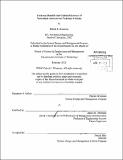Technical benefits and cultural barriers of networked Autonomous Undersea Vehicles
Author(s)
Wineman, Patrick L
DownloadFull printable version (5.349Mb)
Other Contributors
Massachusetts Institute of Technology. Engineering Systems Division.
Advisor
James M. Utterback.
Terms of use
Metadata
Show full item recordAbstract
The research presented in this thesis examines the technical benefits to using a collaborative network of Autonomous Undersea Vehicles (AUVs) in place of individual vehicles. Benefits could be achieved in the areas of reduced power consumption, improved positional information and improved acoustic communication bandwidth. However, current culture of AUV development may impede this approach. The thesis uses the Object Process Methodology (OPM) and principles of System Architecture to trace the value of an AUV system from the scientist who benefits from the data to the vehicle itself. Sections 3 and 4 outline the needs for an AUV system as they currently exist and describe the key physics-based limitations of operations. Section 5 takes a broader look at the system goal as data delivery, not just the deployment of a vehicle, and introduces the concept of networked AUV. Section 6 describes a potential evolution of networked AUVs in increasing autonomy and collaboration. Finally, Section 7 examines AUV development cultures that could impede, or foster, networked vehicles.
Description
Thesis (S.M.)--Massachusetts Institute of Technology, Engineering Systems Division, 2013. Cataloged from PDF version of thesis. Includes bibliographical references (p. 44-45).
Date issued
2013Department
Massachusetts Institute of Technology. Engineering Systems DivisionPublisher
Massachusetts Institute of Technology
Keywords
Engineering Systems Division.